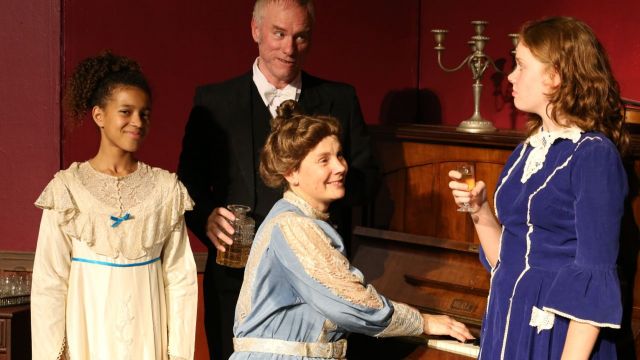James Joyce’s The Dead
The musical version of James Joyce’s acclaimed short-story The Dead from the Dubliners is not your typical piece of musical theatre. More a play with songs, the work recalls an earlier time when families gathered around the piano and sang favourite tunes. There was no traditional orchestra as such with members of the cast playing various musical instruments on stage; piano, fiddle, flute, concertina and a bodhran (an Irish Frame Drum).
Set in Dublin in 1904, the action takes place almost entirely in the parlour of the piano-teaching Markan sisters, Kate and Julia, and centres around their annual musical Christmas gathering of family and friends where they sing, dance, eat and imbibe. Richard Nelson’s adaptation of Joyce’s novella won him a Tony Award in 1999 for Best Book of a Musical, and it’s in the second act of the musical where his fine adaptation takes flight when the protagonist, author and journalist, Gabriel Conroy has a powerful epiphany. During the evening his wife Gretta is emotionally affected by a song that reminds her of when she was seventeen and in love with a boy named Michael Furey back in Galway. Having never talked of it with her husband, Gabriel is stunned to realise the depth of feeling Gretta had for the boy and makes him question her love for him. This moment is beautifully realised in Villanova’s Australian premiere production and as played by Leo Bradley as Gabriel and Tia Wilke as Gretta was one of the most effective sequences in the whole musical. Bradley also captured the insecurities and social awkwardness of Conroy and was a commanding strength in the ensemble numbers and as a narrator.
Gary Conwell as the inebriated Freddy was also a strength and shone in his “Three Jolly Pigeons” number, a song whose lyric was adapted from Oliver Goldsmith’s She Stoops to Conquer. Best number in the show however was “Naughty Girl”, interpolated from Lionel Monkton’s 1898 comic opera A Greek Slave. It started as a duet with the aging Markan sisters, Aunt Kate (Morna Kassulke) and Aunt Julia (Pat Wockner), with parasols and developed into a lively chorus with the entire cast.
Rosemary Murray was a spirited Mary Jane and Amelia Burton a pretty and sweet Young Julia especially in the reprise of “When Lovely Lady Stoops to Follow”, another lyric adaptation from Goldsmith. Shaun Davey and Richard Nelson’s original score was mostly of the folk-song variety and at times was maudlin, but Lynette Wockner’s reel and jig dances were lively additions.
Having the musical instruments played on stage meant that the actors frequently had to fight the orchestra to be heard. Vocally the men outshone the women. Rod Thompson’s large cast successfully handled the Irish brogue with the ladies looking particularly graceful in their Edwardian dresses.
The Dead is a melancholic work which captures the turn-of-the-century period and for the most part, the elegiac beauty of Joyce’s writing.
Peter Pinne
Subscribe to our E-Newsletter, buy our latest print edition or find a Performing Arts book at Book Nook.

